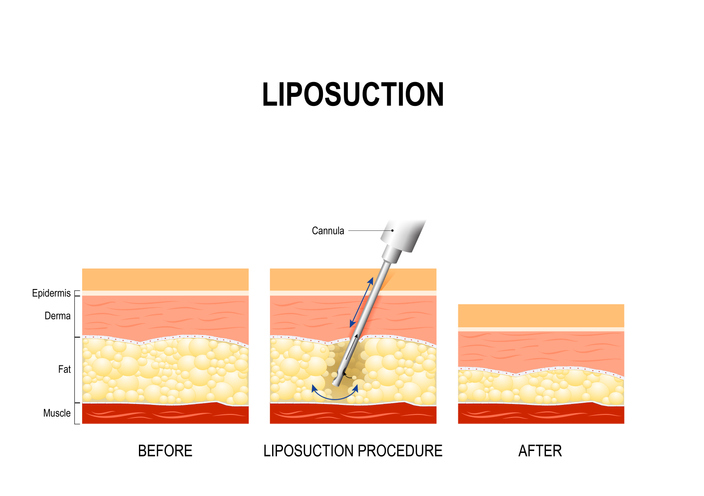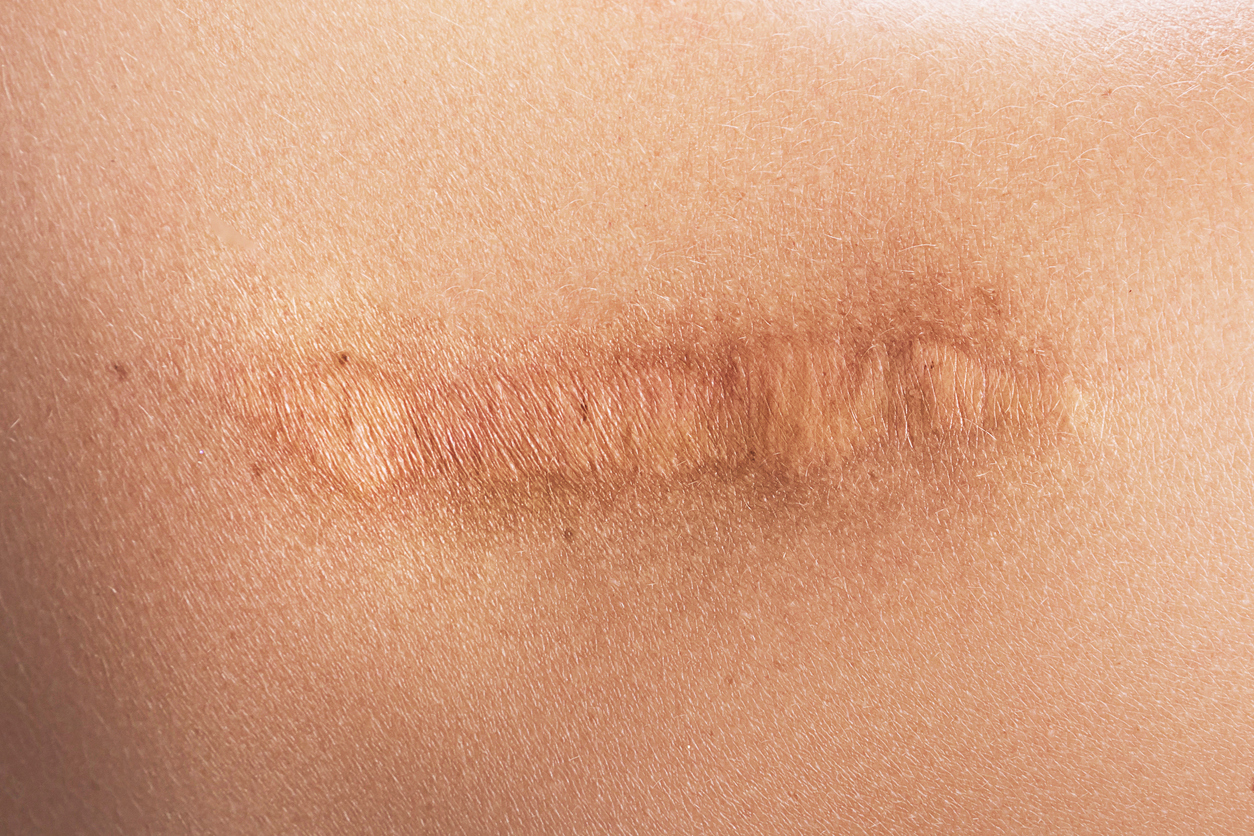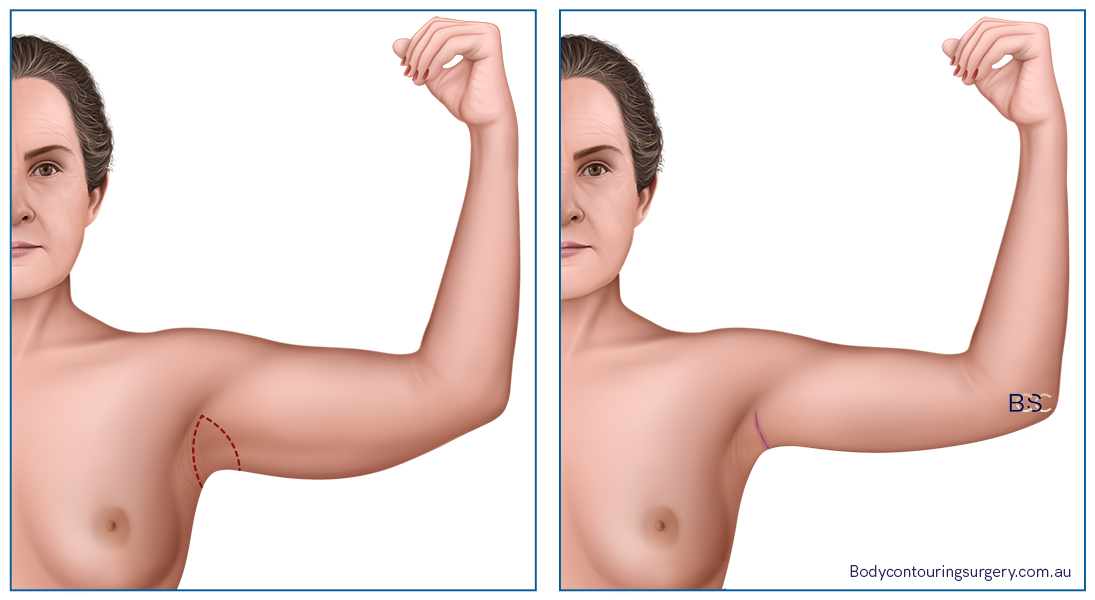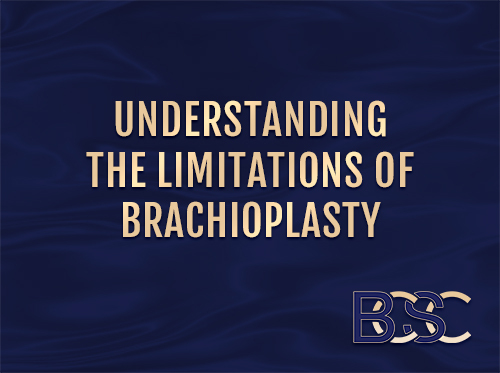The History of Brachioplasty Surgery
Arm lift surgery has evolved over the last century as surgeons refined their techniques. The earliest arm reductions, first pioneered in 1930, were crude procedures. Modern brachioplasty has advanced tremendously since then, offering more refined cosmetic results and improved safety. The latest arm lift techniques feature liposuction and better scar placement.
Timeline of Brachioplasty Innovations
- 1930: Thorek – Early Description of Upper Arm Reduction Surgery in Obese Patients (Ref 24, 30, 32)
- 1943: Posse – Elliptical Incision (Ref 24, 27, 30)
- 1954: Correa-Iturraspè and Fernandez – First Description of Aesthetic Arm Lift Surgery (Ref 9, 24, 30)
- 1973: Lewis – Z-plasty (Ref 24, 30)
- 1975: Pitanguay – S-Shaped Incision (Ref 24, 25, 30)
- 1975: Arpad and Fischer – Modern Liposuction Techniques Introduced (Ref 5, 13, 30)
- 1977 – Pitanguay – Bat-Wing Torsoplasty (Ref 24, 26, 30)
- 1977: Franco and Rebello – L-Shaped Incision (Ref 14, 30)
- 1979: Guerrero-Santos – Lenticular Excision (Ref 17, 30)
- 1979: Juri – Quadrangular Flap and T-closure (Ref 19, 30)
- 1980: Regnault – Fishtail Variant Incision (Ref 29, 30)
- 1982: Borges – W-plasty Incision (Ref 6, 30)
- 1983: Regnault – Axilloplasty (Ref 28, 30)
- 1985: Avelar – Liposuction Added to Body Contouring Procedures (Ref 30)
- 1989: Goddio – Deepithelialization and Repositioning of the Posterior Arm Flap to Create a Bicipital Groove (Ref 16, 30)
- 1995: Lockwood – Superficial Fascial System Suspension (Ref 22, 30)
- 1996: Marques – Excision of Loose Skin on the Brachia, Axilla, and Elbow (Ref 23, 30)
- 1997: Gilliland and Lyos – CAST Liposuction as an Alternative to Brachioplasty (Ref 15, 30)
- 2000: de Souza Pinto – Brachioplasty Technique Using S-Shaped Molds (Ref 10, 30)
- 2001: Richiards – Minimal-Incision Brachioplasty (Ref 30)
- 2004: Strauch – Sinusoidal Incision (Ref 30, 31)
- 2006: Chandawarkar – Fish-Incision (Ref 8, 30)
- 2006: Aly – Double-Ellipse Incision (Ref 3, 30)
- 2006: Hurwitz – Inverted L-Shaped Incision (Ref 18, 30)
- 2006: Aly – T-Brachioplasty (Ref 4, 30)
- 2007: Hoyos and Maillard – VASER Liposuction Introduced (Ref 2)
- 2013: Aboul Wafa – S-Shaped Incision Placed Medially (Ref 1, 30)
- 2013: Bracaglia – Kris Knife Incision (Ref 7, 30)
- 2014: Knotts – Avulsion Brachioplasty (Ref 20, 30)
- 2014: Fantozzi – BTV Arm Lift Technique (Ref 11, 30)
- 2014: Kornstein – Fascial Support with a Silk-Derived Surgical Scaffold (Ref 21, 30)
- 2015: Ferraro – Modified Fishtail Incision (Ref 12, 30)

The Earliest Attempts at Arm Reduction Surgery (1930-1954)
Correa-Iturraspè and Fernandez were credited with the first description of aesthetic arm lift surgery in 1954 (Ref 9), although previous authors had discussed arm reductions dating back to the early Twentieth Century. (Ref 24) In 1930 and 1943, respectively, Thorek and Posse described preliminary attempts at removing excess tissue from the upper arms of overweight patients using an elliptical incision. (Ref 27, 32)
Introduction of New Arm Lift Incision Patterns (1973 to 1980)
Not much had changed since the 1950s, as arm lifts were still an uncommon surgical procedure. Then, in the latter half of the Twentieth Century, several surgeons presented newer arm contouring techniques, introducing modified incision patterns and scar placements.
In 1973, Lewis introduced Z-plasty, a brachioplasty procedure that carried the arm resection into the armpit with an emphasis on reducing abnormalities of the scar line. (Ref 24, 30)
Then, in 1977, famed Brazilian plastic surgeon Dr Ivo Pitanguay introduced a variation in arm lift surgery known as ‘bat-wing torsoplasty’, which likewise extended the upper arm incision into the armpit for patients with redundant skin in the axilla. (Ref 26, 30) Pitanguay had also discussed using an S-shaped incision prior to this in 1975. (Ref 24, 25, 30)
Franco and Rebello were first credited with describing a surgical procedure known as L-shaped brachioplasty incision in 1977. (Ref 14, 30) Two years later, in 1979, Guerrero-Santos introduced the lenticular incision,(Ref 17, 30), and Juri described his method of a quadrangular flap and T-closure that same year. (Ref 19, 30)
Development of Modern Liposuction Techniques (1975)

Cosmetic surgeons Arpad and Fischer had reached a new milestone in aesthetic surgery when they developed modern liposuction techniques in the late 1970s. (Ref 5, 13) By the late 1980s, tumescent liposuction had gained popularity among body contouring patients in North America. It was only a matter of time before adding liposuction to brachioplasty procedures became more common.
New Variations in Brachioplasty (1980s)
The 1980s were a time of new ideas in upper arm contouring. In 1980, Regnault described a fishtail variation of upper arm reduction surgery. (Ref 29, 30) Many surgeons since then have based their surgical techniques on his method, albeit with refinements. Regnault also made contributions, focusing on excess skin within the armpit, in 1983. (Ref 28) One of his contemporaries, Borges, is credited with introducing the W-plasty upper arm incision around the same year. (Ref 6, 30)
In 1989, Goddio attempted to refine arm contouring procedures, describing a technique that aimed to create a nicely defined bicipital groove by deepithelializing and repositioning the posterior upper arm flap. (Ref 16, 30)
Early Attempts at Combining Liposuction and Body Contouring Procedures (1985)
Brazilian surgeon Dr Juarez M. Avelar is credited as one of the first to successfully perform liposuction-assisted tummy tuck surgery, which ultimately led to other surgeons experimenting with adding liposuction to upper arm lift procedures. Previously, liposuction and arm lift surgery were generally not combined. (Ref 30)
Refining and Modernising Brachioplasty Techniques (1990s)
Up until the 1980s, the results of arm lift surgery were somewhat unpredictable. That began to change in the 1990s. As the Twentieth Century drew to a close, surgeons had a deeper understanding of anatomy and how they could use it to their advantage when contouring the upper arms.
In 1995, Dr Ted Lockwood described a novel approach called fascial system suspension brachioplasty. His technique involved securely anchoring the upper arm flap to the axillary fascia, which he found improved the appearance of the surgical scars and yielded a more natural-looking upper arm contour post-surgery. (Ref 22, 30)
A year later, Brazilian surgeon Dr Marques made one of the first attempts at removing excess skin from the arm, armpit, and elbow in one procedure. (Ref 23, 30)
In 1997, Gilliland and Lyos described cases in which patients declined upper arm lift surgery and instead underwent upper arm liposuction due to concerns regarding the size of the surgical scars. The surgeons discussed a CAST (Circumferential para-Axillary Superficial Tumescent) liposuction technique to reduce excess subcutaneous fat in the upper arms while at the same time tightening excess skin.
Their technique isolated the fat cells by applying lidocaine and adrenaline followed by 360-degree liposuction around the upper arm and adjacent areas, removing both subdermal and superficial fat deposits. (Ref 15, 30) Twenty-six patients underwent the procedure. While the authors observed the outcomes were relatively good in patients with mild skin laxity, nearly 39 percent developed complications of seroma, and two in 26 patients later underwent a traditional brachioplasty procedure to achieve the skin-tightening results they sought (Ref 15)
Brachioplasty in the Early Century (2000-2006)

Near the turn of the century, removing excess upper arm skin and fat with brachioplasty had become a more advanced endeavor. However, the aesthetic results were still not quite as refined as they could be. Some patients were left with obvious scars that detracted from their final cosmetic outcome. Minimising the appearance of the surgical scars after upper arm lift surgery became the focus of surgeons in the 2000s.
To improve scar symmetry, de Souza Pinto and his colleagues proposed using double S-shaped molds to mark the incisions before cutting away excess skin from the upper arms. In 2000, the authors reported that using the molds resulted in smaller and more symmetrical upper arm lift scars. (Ref 10, 30)

Dr Mark E. Richiards also made a contribution when he proposed the minimal incision brachioplasty, a technique that resulted in small, discreet surgical scars hidden in the armpit. (Ref 30) The minimal incision technique had an advantage over traditional arm lifts, which produced a long scar on the upper arms that was highly visible in sleeveless and short-sleeve tops. While still used today, minimal incision brachioplasty is generally only recommended for patients with minor skin laxity.
In 2004, Dr Berish Strauch and his colleagues in New York pioneered an upper arm lifting technique featuring a sinusoidal incision on the rear upper arms. The authors stated the curvy incision helped to camouflage the scar to an extent and lowered the risk of contracture of the skin closure. The curved incision terminated in the armpit and finished with a Z-plasty incision in the axilla. (Ref 30, 31)
By 2006, surgeons had also modified the fishtail incision and experimented with a double ellipses incision. (Ref 3, 8, 30) Dr Dennis Hurwitz proposed an inverted L-shaped incision, another attempt at masking the surgical scars. (Ref 18, 30) That same year, Dr Al-Aly of Missouri published an article in the Aesthetic Surgery Journal describing T-closure brachioplasty.
Introduction of VASER Liposuction (2007)
Vaser Lipo – Liposuction – Prof. Dr. Ferit Demirkan
Surgeons had been performing liposuction-based arm lifts more often in recent years. In 2007, Colombian plastic surgeon Dr Alfredo Hoyos introduced an exciting new advancement in liposuction known as VASER liposculpture. (Ref 2) VASER (Vibration Amplification of Sound Energy at Resonance) dislodges fat cells using ultrasonic vibrations, a far gentler process than conventional liposuction, which relied on the surgeon to break up fat cells with manual force before extracting the fat with suction. While standard liposuction remains popular today, many surgeons consider VASER the “gold standard” of liposuction and soon adopted it as their technology of choice when performing liposuction-assisted arm lifts.
Brachioplasty Surgery: Advancements in the Last Decade (2013-2023)
Aboul Wafa proposed a modified S-shaped incision placed on the inner arm in an attempt to produce a scar that would not contract. (Ref 1, 30) Bracaglia and colleagues sought to expand on Aboul Wafa’s concept with a kris-knife incision to further reduce tension on the scar. (Ref 7, 30)
Knotts and his colleagues reviewed 44 arm lift patients over five years, concluding in a 2014 medical paper that avulsion brachioplasty produced a finer, thinner incision than previous techniques. The avulsion technique utilises liposuction to remove excess fat within the ellipse of excess skin that is to be removed. (Ref 20, 30)
2014 was also the year Fantozzi suggested a brachial lifting technique using a BVT (balanced triple-vector) approach with dual-opposing flaps. His approach employed a superficial resection that resulted in less damage to the lymphatic network and subcutaneous tissue. Fantozzi concluded his method led to a more predictable cosmetic outcomes, lower complication rates, and fewer incidents of scar contraction. (Ref 11, 30)
Poor scarring was still an issue for surgeons. Even as recently as 2014, a “predictable scar remains a challenge for the surgeon and the patient. The scar often heals slowly and widens over time, perpetuated by the effects of gravity, body movements, and the thin nature of the superficial fascial system (SFS) of the arm”. (Ref 21) Kornstein was the first to propose supporting the superficial fascial system with a silk-derived surgical scaffold (SERI). (Ref 21, 30)
Fish-incision brachioplasty had been around for many years. In 2015, Dr Giuseppe Ferraro and his colleagues proposed an update to the fishtail incision, hoping to improve the armpit contour and camouflage the arm lift scar. (Ref 12, 30)
The authors described it as follows:
“Our modifications to the original technique focus on incision placement along the medial bicipital groove and armpit, based on the drawings of the tails following dynamic lines of the armpit contour established by the underlying muscles. We drew the tails slightly with a 60° angle between the tails and the width depending on patient’s arm contour and on the excess of the skin in the armpit to be removed.” (Ref 12)

Disclaimer: Operation performed by Dr Bernard Beldholm. Adult content, surgery has risks; individual results vary, seek 2nd opinion. Please see the full disclaimer.
Conclusion
Today, arm lift surgery is popular among massive weight loss patients and those with excess skin due to ageing. Conspicuous scarring remains the top aesthetic concern of surgeons and patients. Arm lift techniques will continue evolving as surgeons attempt to better camouflage the arm lift scars.
Safety has also improved greatly over the last century. Possible complications such as prolonged or permanent numbness due to nervy injury (specifically, medial brachial cutaneous nerve damage), allergic reaction, and potentially fatal cardiovascular complications, are still possible, although they are extremely rare today.
References
- Aboul Wafa AM. S-shaped brachioplasty: an effective technique to correct excess skin and fat of the upper arm. Plastic and reconstructive surgery. 2013;131:661e–3e.
- AE Hoyos, JA Millard, “VASER-assisted high-definition liposuction”, Aesthetic Surgery Journal, 27(6):594-604, 2007 Nov-Dec
- Aly A, Pace D, Cram A. Brachioplasty in the patient with massive weight loss. Aesthetic surgery journal/the American Society for Aesthetic Plastic surgery. 2006;26:76–84.
- Aly AS CA. St Louis (Missouri): Quality Medical Publishing, Inc; 2006. Brachioplasty. Body Contouring after massive weight loss 1st ed: pp. 303–33.
- Bellini, Elisa, et al. “A Journey Through Liposuction and Liposculture: Review.” Annals of Medicine and Surgery, vol. 24, Elsevier BV, Dec. 2017, pp. 53–60.
- Borges AF. W-plastic dermolipectomy to correct “bat-wing” deformity. Annals of plastic surgery. 1982;9:498–501.
- Bracaglia R, D’Ettorre M, Gentileschi S, Mingrone G, Tambasco D. “Kris knife” brachioplasty after bariatric surgery and massive weight loss. Aesthetic Plast Surg. 2013;37:640–2.
- Chandawarkar RY, Lewis JM. ‘Fish-incision’ brachioplasty. Journal of plastic, reconstructive & aesthetic surgery: JPRAS. 2006;59:521–5.
- Correa-Iturraspè M FJ. Dermatolipectomia braquial. Prensa Med Argent. 1954:2432.
- de Souza Pinto EB, Erazo PJ, Matsuda CA, et al. Brachioplasty technique with the use of molds. Plastic and reconstructive surgery. 2000;105:1854–60. discussion 61-5.
- Fantozzi F. Brachial lifting using the balanced triple-vector (BTV) technique with dual opposing flaps. European journal of plastic surgery. 2014;37:95–102.
- Ferraro GA, De Francesco F, Razzano S, D’Andrea F, Nicoletti G. Modified Fish-Incision Technique in Brachioplasty: A Surgical Approach to Correct Excess Skin and Fat of the Upper Arm (Restoring the Armpit Contour) Aesthetic plastic surgery. 2015
- Fischer A., Fischer G. First surgical treatment for molding body’s cellulite with three 5 mm incisions. Bull. Int. Acad. Cosmet. Surg. 1976;3:35.
- Franco T. Rio De Janeiro: Atenueu; 1977. Cirurgia Estetica.
- Gilliland MD, Lyos AT. CAST liposuction: an alternative to brachioplasty. Aesthetic plastic surgery. 1997;21:398–402.
- Goddio AS. A new technique for brachioplasty. Plastic and reconstructive surgery. 1989;84:85–91.
- Lenticular incision Guerrero-Santos J. Brachioplasty. Aesthetic plastic surgery. 1979;3:1–14.
- Hurwitz DJ, Holland SW. The L brachioplasty: an innovative approach to correct excess tissue of the upper arm, axilla, and lateral chest wall skin. Plast Reconstr Surg. 2006;117:40311. discussion 12-3.
- Juri J, Juri C, Elias JC. Arm dermolipectomy with a quadrangular flap and “T” closure. Plastic and reconstructive surgery. 1979;64:521–5.
- Knotts CD, Kortesis BG, Hunstad JP. Avulsion brachioplasty: technique overview and 5-year experience. Plastic and reconstructive surgery. 2014;133:283–8.
- Silk-derived surgical scaffold (SERI) as an adjunct to conventional brachioplasty Kornstein AN. SERI Surgical Scaffold as an Adjunct to Conventional Brachioplasty. Plastic and reconstructive surgery Global open. 2014;2:e190.
- Lockwood T. Brachioplasty with superficial fascial system suspension. Plastic and reconstructive surgery. 1995;96:912–20.
- Treatment of brachial, axillary, and elbow segments Marques B AA. Dermolipectomia braquial. Rev Soc Bras Cir Est Reconst. 1996;11
- O’Toole, James, et al. “The History of Body Contouring Surgery.” Seminars in Plastic Surgery, vol. 20, no. 01, Thieme Medical Publishers (Germany), Jan. 2006, pp. 005–08.
- Pitanguy I. Abdominal lipectomy. Clinics in plastic surgery. 1975;2:401–10.
- Pitanguy I. In: JM Converse, editor. Reconstructive Plastic Surgery. 2nd ed. Philadelphia, PA: WB Saunders; 1977. Dermolipectomy of the abdominal wall, thigh, buttocks and upper extremity. pp. 190–198. [Ref list]
- Posse P. Buenos Aires: Athenue; 1943. Cirurgia Estetica.
- Regnault P. Brachioplasty, axilloplasty, and pre-axilloplasty. Aesthetic plastic surgery. 1983;7:31–6.
- Regnault P. In: Ely JF, editor. Transactions of the Seventh International Congress of Plastic and Reconstructive Surgery. Sao Paulo, Brazil: Cartgraf; 1980. Brachioplasty, axilloplasty and preaxilloplasty. [Ref list]
- Sisti, Andrea, et al. “Complications Associated With Brachioplasty: A Literature Review.” PubMed, vol. 88, no. 4, National Institutes of Health, Jan. 2018, pp. 393–402.
- Strauch – Sinusoidal incision Strauch B, Greenspun D, Levine J, Baum T. A technique of brachioplasty. Plastic and reconstructive surgery. 2004;113:1044–8. discussion 9.
- Thorek M. Esthetic surgery of the pendulous breast, abdomen and arms in females. Illinois Medical Journal. 1930;3:48–57.



